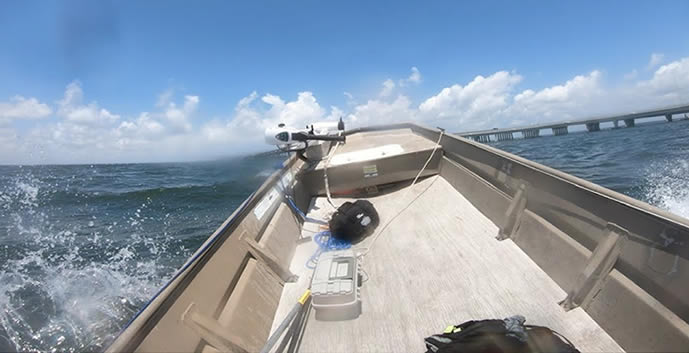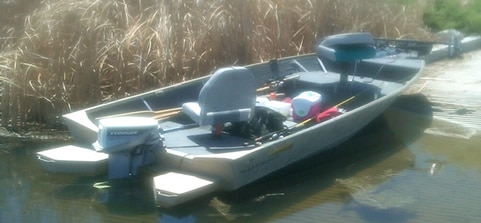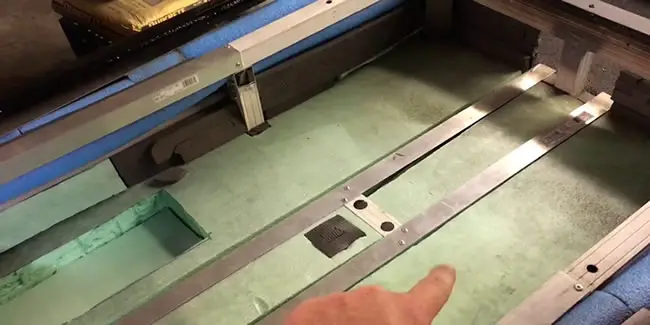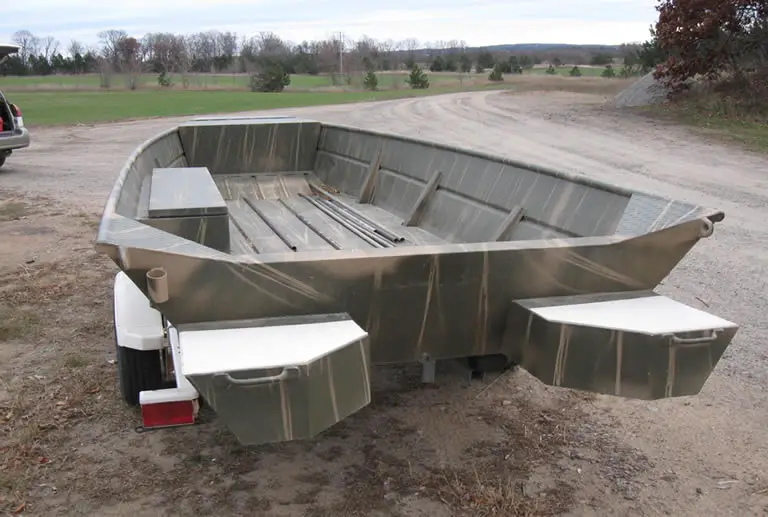Contents
How To Make A Jon Boat Float Better With More Stability
Here we will outline how to make your Jon boat float better in all kinds of waters.
How do you make a Jon boat float better?
To make a Jon boat float better you need to increase its buoyancy. This can be done by attaching flotation devices to it.
Floating devices attached to key points of a Jon boat not only makes the boat more buoyant but it also makes it more stable.
Adding foam to a Jon boat will make it float close to the water surface if the boat it sinks but won’t make it float better under normal circumstances.
Troubleshooting why your Jon boat doesn’t float the way you’d like
If you are having buoyancy problems with your Jon boat and think it is not floating as well as it should, consider if you are asking too much from your boat.
Jon boats are designed to be exceptionally stable and buoyant in calm water and when they are operated within their own limits.
If your boat is not performing as well as it should it may be an indication that you are using it in ways it was designed to be used.
Below are some common reasons Jon boats don’t perform as well as they should.
Use this troubleshooter to see if you can identify potential problems with your boat.
Things that make a Jon boat less buoyant:
Overloading is the most common cause of stability issues
Exceeding the weight capacity of your boat will cause it to sit deeper in the water.
A Jon boat naturally has a low freeboard so excessive weight can cause it to sit so low in the water that the slightest wave or rocking can cause it to take on water.

Ensure you know the weight capacity of your Jon boat and don’t go over it.
You may also want to calculate the combined overall weight by also knowing the weight of your boat.
Overpowering the boat can also cause serious issues on the water
Using a motor that has a HP that is too powerful for your Jon boat can cause serious stability and buoyancy issues.
Make sure you have the correct outboard motor on your Jon boat.
A motor that is bigger than the recommended size for your boat will not only cause stability issues but will weigh down the boat.
A heavy boat will float very low in the water, especially at the stern. This can be dangerous on a flat bottom boat for reasons I will now discuss.
Rough water and Jon boats don’t mix!
A Jon boat was never designed to be used in rough water.
Although the flat bottom hull and low freeboard make Jon boats by far the most versatile personal-use shallow water vessel they only perform well in calm waters.
The very same qualities that make the Jon boat an amazingly good calm-water utility vessel make it a very bad boat for use in rough water.

If you use a standard Jon boat in rough water frequently then you should consider swapping it for a semi-v (also known as a mod-v) Jon boat.
See our guide to different types of Jon boat.
Alternatively you should consider getting a different shallow water boat which is better suited to rough water, like a Drift boat.
Using the boat in unsuitable environments is also a major cause for flotation & stability issues
Because a Jon boat doesn’t play well in rough water it doesn’t it perform at its best if it is used in marine environments that are challenging – like the ocean.
You may be using your Jon boat in marine environments for which it is unsuitable.
Make sure you are using your Jon boat in the type of water it was designed to be used in.
If you have been using it in unsuitable environments then you may need to rethink your boating practices or simply get a different boat.
If you need to know where a Jon boat should be used and where it should not be used read this article.
The 2 most effective ways to increase buoyancy on a Jon boat
If you have went through all the troubleshooting points above and are still unsatisfied with how your Jon boat floats you can take steps to make it more buoyant.
There are very specific ways to do this and there is a lot of misunderstanding about increasing the buoyancy of a boat, especially among novice boaters.
You can only add buoyancy to your Jon boat, to make it more stable and float better, by attaching buoyancy aids to the outside of the boat.
Many people believe that they can simply add foam to their Jon boat and it will become more buoyant in the water.
This is not the case!
Trying to make a boat more buoyant by adding anything to the inside of the boat will have no effect at all on how the boat floats.
There is a very good reason for adding foam to the inside of your Jon boat, which we will cover below, but as an aid to improving flotation while on the water, foam will have zero effect.
Below are two very effective ways for increasing the buoyancy of your Jon boat.
2 very effective ways to help your Jon boat float better:
- Add flotation pods.
- Add outriggers.
Add flotation pods – Jon boat float pods are the most common way to add extra buoyancy
Adding these type of boat stabilizers to your Jon boat can help to stabilize things a lot.
These type of Jon boat float pods are on of my favorite way to stabilize a flat bottom utility boat.
Flotation pods are an excellent method for increasing buoyancy on a Jon boat.

Because these Jon boat pods are attached to the stern of the boat they also help to counteract the weight of the outboard motor. It’s a win-win.
Float pods for a Jon boat can be store-bought or homemade and are very easy to install.
Below is an image of a Jon boat with typical flotation pods attached.
Add outriggers – a less popular solution as it increases the beam of the boat
Outriggers are also used to give a Jon boat better buoyancy and increased stability on the water.
Outriggers are a great way to make your Jon boat float better by decreasing side rocking.
They also allow you to add more weight to your boat because they make the boat float better.
The size of the outriggers you choose will depend on the design and the size of your Jon boat.
Outriggers can be permanently attached to your Jon boat or they can be detachable so you can remove them when you don’t need them and want to shed some weight from your boat.
There are many different types of outriggers available.
A very common type is made from lightweight PVC. 2 hollow PVC tubes sit parallel to each side of the boat to offer better stability and increased buoyancy.
Below is an image of two common types of outriggers fitted to Jon boats.

Be aware that adding outriggers to a Jon boat will greatly increase the beam of the boat.
Increasing your Jon boat beam width can replace your buoyancy problems with different problems.
See our article on how to measure the beam of a boat for more information on these potential problems.
The secondary positive effects of increasing buoyancy
By increasing your Jon boat’s buoyancy you will also help to stabilize the boat.
As we pointed out in a previous article, how to make a Jon boat more stable, adding flotation pods and/or outriggers to a Jon boat greatly stabilizes it.
Adding foam to aid flotation works but not in the way you think!
Contrary to popular opinion adding foam to your Jon boat will not make it more buoyant.
A Jon boat it will float no better or worse on the water if it is filled with foam or not.
Basically anything, no matter how buoyant, that is placed in a boat has no effect on its buoyancy at all and will in fact just add to the boat’s weight – thus having the opposite effect.
In order for foam to make a Jon boat more buoyant on the water the foam would need to be added to areas of the boat that are under water, such as the bottom of the boat.
Doing this is not an option as it would not only negatively impact the performance of the boat but the foam wouldn’t stay in place anyway.
So why do some people put foam on the deck of their Jon boats?
Good question!
Adding foam to a Jon boat helps it float in the water when the boat sinks.
Thus making recovery of the boat easier.
Adding foam to your Jon boat may not make it float better when in use but it could save you a lot of hard work and money should your boat take on water and start to sink.

A sunk boat that is has a foam fill in it will float near the top of the water rather than sinking to the bottom.
If your Jon boat gets submerged then the foam in it, that is lighter than water, will rise to the surface and take the boat with it (albeit with a full load of water).
This makes recovery of the Jon boat much easier but it also means you are much less likely to lose equipment that is on the deck of the boat.
It also helps with the safety of passengers on the boat.
Even if the boat floats just below the surface, where only the deck is level with the water surface, it will allow boaters to stay with the boat using it as a giant float.
The good news is that adding foam to your Jon boat is very easy.
You can simply glue in foam sheets to the decking or use a special liquid urethane that you can pour and mold so you get into all those nooks and crannies.

